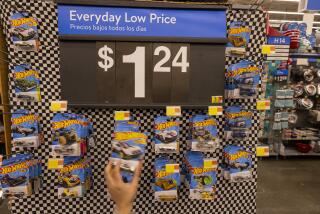Retailers Bring Computer Codes to Inventory Control : System Similar to Grocers’ Speeds Service, Cuts Cost
- Share via
TROY, Mich. — When a 9-year-old boy in Topeka, Kan., badgers his mother into buying him a GI Joe doll at K mart, toy buyers at the discount chain’s headquarters in Michigan know the same day.
K mart Corp., the nation’s second-largest retailer, is linking its thousands of stores into a single computer information system to gain unprecedented control over its far-flung inventory.
The company is nearly one-fifth of the way through a conversion of checkout lanes from manually keyed cash registers to scanners that read bar codes printed on boxes by the manufacturers.
Slow to Respond
The transformation is familiar to anyone who has shopped in a supermarket lately. But the discount retail business has been slow to respond to the advantages of such computer wizardry.
“When all stores are up, every night we will add about 10 million pieces of information to our file,” said David M. Carlson, K mart vice president for corporate information systems.
K mart’s conversion accelerates a national movement among retailers toward adoption of a single standard for coding products and their prices in a form computers can read.
“The fact that they’re going to an industry standard certainly is meaningful, and it will be able to establish a unified front for the industry,” said J. Joseph Miller, director of retail standards and technology for the National Retail Merchants Assn. in New York.
A single coding standard is needed so manufacturers can mark their products in a way that can be used by a large number of stores.
For K mart, it’s a matter of efficiency. Officials for the company say the payoff will come in better stocked shelves and less time for customers waiting to checkout.
“It allows us to collect the actual movement of an item by day by store, so we know, in Southern California, for example, what versions of GI Joe characters sold yesterday,” said Carlson.
Bringing more than 2,200 K mart stores into the computer age is the largest such project ever undertaken by a retailer, according to the National Retail Merchants.
K mart plans to spend $500 million on retail automation, with half of that going for new terminals, scanners and other checkout equipment, Carlson said.
The company installed its first scanner three years ago and so far has automated 410 of its discount department stores, Carlson said. The retailer’s goal is to have all its stores linked to a network by October, 1990.
Altogether, the system will track about 150,000 items through 50,000 scanners at checkout counters, he said.
The transactions will be stored on a microcomputer in each store and sent each night to K mart’s Troy headquarters, where they will be compiled into a database holding 1 trillion characters of information. Eventually the data will be transferred by satellite.
The system “allows us to spot trends earlier, to better understand our replenishment reorder requirements,” Carlson said.
K mart’s system is based on the Universal Product Code, a system that uses printed bars of varying width to encode product and price information. The UPC was endorsed last year by the board of the merchants association.
“The last several years, equipment to go with it has advanced significantly, so we felt we should endorse UPC as a direction for general merchandisers to follow,” Miller said.
Only 15% of discount retailers surveyed by the merchants association were using UPC last year, while 65% used printed labels. Five years earlier, the association found 78% were using printed labels and none were using UPC equipment.
“It has probably improved the checkout time by 25%,” said Ray Moore, manager of a K mart discount store in Troy, a Detroit suburb.
The accountants in K mart’s headquarters, however, may tend to look more at the tighter control over inventory the system allows.
“When we have less in our inventory, we have a substantial impact on our debt structure,” Carlson said. “Even an improvement of 20% in inventory would produce tens of millions of dollars in reduced interest expenses.”
More to Read
Inside the business of entertainment
The Wide Shot brings you news, analysis and insights on everything from streaming wars to production — and what it all means for the future.
You may occasionally receive promotional content from the Los Angeles Times.










